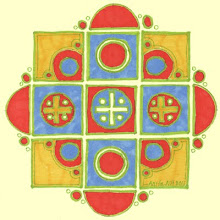Using the same sequence of moves, bottom Left UP, top Right DOWN, 1/4 counter-clockwise
turn, continue braiding. Only now you will begin to braid in beads. Slide one bead down to the center as you move a cord up, and do the same when you move a cord down. Each cord you move will be under the adjacent cord. Position the bead so that it slides under the adjacent cord to lock it in place. The first four placements seem awkward, but once a few beads are in place, each bead that you braid will move into position like a puzzle.
Maintain tension in order to form an even braid. I am always tightening the cords as I braid, and I keep my braid in the center of the wheel. If the bead does not want to slip into place, try putting a little tension by pulling down on the braid from below. The goal is to have no thread showing between the beads in the finished braid.
Some people like to hang a weight from the finished end of the braid. In general I do not like to use a weight because it can result in your thread showing if too much weight is applied. I apply a bit of tension on the button in the beginning, but as the braid lengthens, the weight of the braid itself is usually sufficient.
Continue braiding until your bracelet is the length you require. You need not braid all of the beads that you have strung on. Also, you can remove the bobbins and string on additional beads if you did not string on enough initially.
After you braid in your last bead, continue braiding with just cord to form the loop for the button. Remember that cord braided without beads will stretch. So when you are 3/4 of the way to having a length of braid that, when formed into a loop will fit around the button, stretch it!
When your last braiding segment is long enough it is time to remove the braid from the wheel. First, take the two opposite cords that you would have exchanged next, remove the bobbins, and then remove them from the slots. Tie them in a square knot to secure the work from un-braiding. Now remove the remaining six bobbins and remove the cords from their slots.
The last step is to finish the loop and your bracelet will be ready to wear. To finish the loop you will need a stiff darning needle with an eye large enough for one strand of cord. A pair of chain nose pliers is useful to pull the needle. The center of the braid is hollow but the space gets tighter as each cord is drawn through. I also like to secure the base of the loop with a thin application of Hypo Cement.
Thread one cord onto the darning needle. Fold the loop over and pierce the needle through the base of the braid right above where the beads begin and pull the cord through tightly. Make a half-hitch knot to secure it and insert the needle down into the beaded part of the braid from the top, through the hollow center about and inch or so and then out through the side of the braid. (It is necessary to take care that the needle exits between beads. If the point of the needle goes through a bead hole, chances are that bead will be broken as the eye is forced through.) Draw the needle and cord out the side of the braid and tighten it but do not trim the cord.
Now thread a second cord onto the darning needle. Insert the needle down into the beaded part of the braid and through the hollow center about an inch and then out through the side like the first cord. Repeat with cords three through seven. Cord eight will be wrapped a few times around the base of the loop and inserted through the center of the braid as before. Your last few cords may fit tightly and require pliers to pull them through.
I find it difficult to maintain a neat wrap while inserting the last cord so I insert the cord first, then wrap the loop remaining above the braid around the base of the loop, and then draw the cord through the rest of the way to tighten the wrap. Using the thin applicator tip, coat the wrapped portion of the loop with Hypo Cement and allow it to dry.
The final step is to trim the cords one at a time by putting a little tension on the cord as you carefully cut it close to the braid. The tension causes the ends to slip back into the braid where they remain hidden. Your bracelet is complete!
Tip #1: Although you can stop and add beads, you cannot add more cord. For this reason I cut my cord generously. This allows me to snip off and discard frayed bits from the end of the cord. You will need about a foot of cord per strand at the end of the braiding process in order to comfortably finish the loop. And it is good practice to avoid braiding in the end of the cord that has been weakened by the needle in the bead-stringing process.
Tip #2: Inspect your work frequently so you catch mistakes early. A hole in the braid will result if you forget to move a bead. Loss of tension will cause a bead to slip into the center of the braid and again a hole will result. You can correct these errors by braiding in reverse.
[Return to Part 1.]
Bracelet No. 87
-
Daily Bracelets and Bead Kits designed by AnitaNH.
See them at Anita's Beads of Wakefield, New Hampshire





